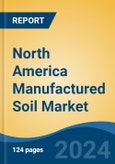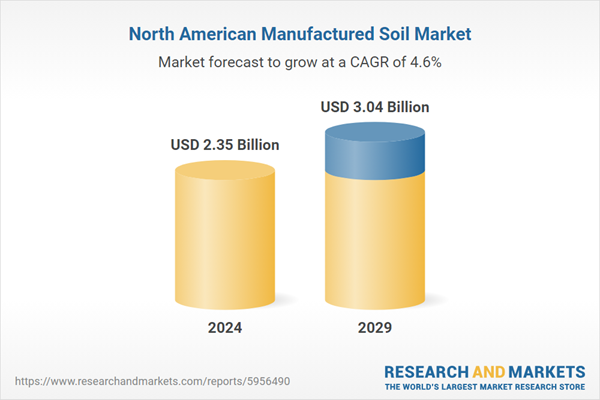Speak directly to the analyst to clarify any post sales queries you may have.
10% Free customizationThis report comes with 10% free customization, enabling you to add data that meets your specific business needs.
One of the key drivers of the market is the increasing adoption of sustainable agricultural practices and the growing trend of urban farming. As urbanization expands, there's a greater emphasis on utilizing manufactured soil for rooftop gardens, vertical farming, and green infrastructure projects in cities across North America.
Moreover, the awareness regarding soil degradation and the need for soil restoration initiatives is boosting the demand for manufactured soil products. These soils are engineered to restore soil health, promote plant growth, and mitigate environmental impacts associated with conventional soil management practices.
Additionally, technological advancements in soil science and manufacturing processes are further propelling market growth, enabling manufacturers to develop customized soil blends tailored to specific crop requirements and environmental conditions.
With favorable government regulations supporting sustainable soil management practices and the increasing adoption of soilless cultivation techniques, the North American manufactured soil market is poised for significant expansion in the coming years. Manufacturers are expected to focus on innovation and product development to cater to the evolving needs of the agricultural and landscaping sectors, driving further growth and opportunities in the market.
Key Market Drivers
Growth in Agriculture Industry
Manufactured soil, also known as engineered or synthetic soil, is a blend of organic and inorganic materials designed to mimic natural soil conditions. It is tailored to specific agricultural needs, offering advantages such as improved nutrient retention, enhanced water retention, and better aeration. These benefits have made manufactured soil an attractive alternative to traditional soil in agricultural applications, driving its adoption across North America.One of the primary drivers of the manufactured soil market is the increasing adoption of soilless farming techniques such as hydroponics, aeroponics, and aquaponics. These methods eliminate the need for conventional soil by using manufactured soil blends as growing mediums. Soilless farming offers several advantages, including higher crop yields, efficient water usage, and the ability to grow crops in non-arable land or urban environments. As farmers seek sustainable and efficient ways to cultivate crops, the demand for manufactured soil for soilless farming continues to rise.
Moreover, the growing trend towards organic farming practices has fueled the demand for manufactured soil. Organic farming relies on natural inputs and avoids the use of synthetic fertilizers and pesticides, making soil quality paramount. Manufactured soil products, formulated with organic materials and devoid of chemical contaminants, provide organic farmers with a reliable medium to support plant growth while maintaining soil health.
Another factor contributing to the growth of the manufactured soil market is the increasing awareness of soil degradation and the need for soil remediation. Traditional agricultural practices, such as monocropping and excessive tillage, have led to soil erosion, compaction, and nutrient depletion. Manufactured soil offers a solution by providing a nutrient-rich substrate that can rejuvenate degraded soils and promote sustainable agricultural practices.
Surge in Technological Advancements
Technological advancements in precision agriculture have revolutionized farming practices, leading to increased demand for manufactured soils. Precision agriculture utilizes data-driven insights, IoT sensors, and GPS technology to optimize crop yields, minimize resource wastage, and improve soil health. Manufactured soils are engineered to provide precise nutrient formulations, pH levels, and water retention capacities, aligning with the requirements of specific crops and growing conditions.With growing concerns over soil contamination and degradation, innovative soil remediation technologies have gained prominence. Manufactured soils are engineered not only for agricultural purposes but also for land reclamation and brownfield redevelopment projects. Advanced remediation techniques such as phytoremediation, bioremediation, and soil washing are complemented by the use of tailored manufactured soils, facilitating the restoration of degraded lands and mitigating environmental risks.
The emergence of smart soil technologies, encompassing sensor-enabled monitoring systems and soil health diagnostics, is reshaping the landscape of soil management practices. Smart soil solutions leverage real-time data analytics to optimize irrigation scheduling, nutrient supplementation, and pest management strategies. By integrating sensors and actuators into manufactured soils, precision agriculture practitioners can achieve greater control over crop production processes, leading to improved resource efficiency and yield outcomes.
Key Market Challenges
Volatility in Sourcing of Raw Materials
Volatility in the sourcing of raw materials presents a significant challenge to the North American manufactured soil market. Manufactured soil, an essential component in various agricultural, horticultural, and landscaping applications, relies heavily on a diverse range of raw materials, including organic matter, minerals, and additives. However, fluctuations in the availability, cost, and quality of these raw materials can disrupt production processes and impact the overall stability of the market.One of the primary factors contributing to volatility in raw material sourcing is climate change. Erratic weather patterns, extreme temperatures, and natural disasters can significantly affect the production and supply of organic materials such as compost, peat moss, and other essential components used in manufacturing soil blends. Droughts, floods, or wildfires can disrupt agricultural activities, leading to shortages and price hikes in raw materials, thereby impacting the manufacturing sector.
Moreover, geopolitical tensions, trade disputes, and regulatory changes can further exacerbate sourcing challenges. Tariffs, sanctions, or import/export restrictions imposed on certain raw materials can disrupt supply chains and increase procurement costs for manufacturers. Political instability in key sourcing regions can also lead to supply chain disruptions, affecting the availability of critical raw materials.
Additionally, the growing demand for sustainable and eco-friendly raw materials adds another layer of complexity to the sourcing process. Manufacturers are under pressure to source materials that align with environmental regulations and consumer preferences, leading to increased scrutiny and stricter sourcing criteria.
Key Market Trends
Rise of Soilless Growing Systems
Soilless growing systems, also known as hydroponics, aeroponics, and aquaponics, involve cultivating plants without the use of soil, relying instead on nutrient-rich water solutions or inert growing mediums. These innovative techniques offer numerous advantages over conventional soil-based farming, including higher crop yields, efficient resource utilization, and the ability to grow crops in diverse environments. As a result, soilless growing systems have gained popularity among commercial growers, urban farmers, and enthusiasts alike, driving the demand for manufactured soil products across North America.One of the key drivers behind the rise of soilless growing systems is their ability to maximize crop productivity while minimizing resource inputs. Hydroponic and aeroponic systems deliver nutrients directly to plant roots in a highly efficient manner, ensuring optimal nutrient uptake and growth. This precise control over nutrient delivery enables growers to achieve higher yields compared to traditional soil-based methods, making soilless growing systems particularly appealing for commercial agriculture.
Moreover, soilless growing systems offer significant water savings compared to conventional farming practices. Hydroponic and aeroponic systems recirculate water within closed-loop systems, minimizing water loss through evaporation and runoff. This water-efficient approach not only reduces agricultural water usage but also mitigates the environmental impact of irrigation, addressing concerns related to water scarcity and pollution in North America.
In addition to water efficiency, soilless growing systems allow for the cultivation of crops in non-arable land or urban environments where soil quality may be poor or limited. Vertical farming, for example, utilizes hydroponic and aeroponic systems to grow crops in vertically stacked layers, maximizing space utilization in densely populated areas. By transforming underutilized spaces into productive growing environments, soilless growing systems contribute to urban food security and resilience.
Segmental Insights
Type Insights
The soil mix segment is projected to experience rapid growth during the forecast period. Soil mixes offer a high level of customization, allowing growers to tailor the composition according to specific plant requirements, soil conditions, and intended applications. This versatility makes soil mixes suitable for a wide range of uses, including agriculture, horticulture, landscaping, urban gardening, and turf management.Soil mixes are formulated to provide optimal growing conditions by incorporating a balanced blend of organic matter, minerals, and additives. These mixes are designed to improve soil structure, nutrient retention, water drainage, and aeration, thereby promoting healthy plant growth and maximizing yields.
With increasing awareness of environmental issues and the need for sustainable agricultural practices, there's a growing preference for soil mixes made from recycled or renewable materials. Many manufacturers are developing eco-friendly soil mix formulations that minimize the use of peat moss and incorporate composted organic matter, coconut coir, perlite, vermiculite, and other sustainable alternatives.
Application Insights
The cultivation segment is projected to experience rapid growth during the forecast period. Climate change poses significant challenges to traditional farming methods, including unpredictable weather patterns, water scarcity, and soil degradation. Manufactured soil products provide growers with a resilient solution to mitigate the effects of climate change on crop production. These soil blends can be customized to improve soil structure, water retention, and nutrient availability, enabling growers to adapt to changing environmental conditions and maintain crop productivity in the face of climate-related challenges.There is a growing emphasis on sustainability and environmental stewardship in the agriculture industry. Manufactured soil offers several environmental benefits, including reduced water usage, minimized soil erosion, and enhanced nutrient management. By promoting sustainable cultivation practices, manufactured soil products help growers mitigate the environmental impact of agriculture while ensuring long-term soil health and fertility. As sustainability becomes a priority for consumers and policymakers, the demand for manufactured soil continues to grow.
Country Insights
United States emerged as the dominant player in the North America Manufactured Soil Market in 2023, holding the largest market share in terms of both value and volume. The United States has the largest economy in North America, providing a significant market size and consumer base for manufactured soil products. With a robust agricultural sector, extensive urban development, and a thriving landscaping industry, there is substantial demand for engineered soils across various applications.The United States boasts a diverse agricultural landscape, encompassing a wide range of crops and production systems. Manufactured soils are utilized in various agricultural applications, including row cropping, specialty crop production, greenhouse cultivation, and nursery operations. The adaptability of engineered soils to different crop types and growing conditions contributes to their widespread adoption across the agricultural sector.
Report Scope:
In this report, the North America Manufactured Soil Market has been segmented into the following categories, in addition to the industry trends which have also been detailed below:North America Manufactured Soil Market, By Type:
- Garden Soil
- Soil Mix
- Manure Compost
- Others
North America Manufactured Soil Market, By Application:
- Cultivation
- Lawns
- Commercial Developments
- Sports fields
- Others
North America Manufactured Soil Market, By Country:
- United States
- Mexico
- Canada
Competitive Landscape
Company Profiles: Detailed analysis of the major companies present in the North America Manufactured Soil Market.Available Customizations:
North America Manufactured Soil Market report with the given market data, the publisher offers customizations according to a company's specific needs.This product will be delivered within 1-3 business days.
Table of Contents
Companies Mentioned
- The Scotts Miracle-GRO Company
- Peaceful Valley Holdings, Inc.
- B.D. White Top Soil Company
- Resource Management, Inc.
- London Rock Supplies Limited
- JIFFY PRODUCTS OF AMERICA INC.
- Boughton Loam & Turf Management Ltd
- Boxley Materials Company
- Casella Waste Systems, Inc.
- Tim O’hare Associates LLP
Table Information
| Report Attribute | Details |
|---|---|
| No. of Pages | 124 |
| Published | April 2024 |
| Forecast Period | 2024 - 2029 |
| Estimated Market Value ( USD | $ 2.35 Billion |
| Forecasted Market Value ( USD | $ 3.04 Billion |
| Compound Annual Growth Rate | 4.6% |
| Regions Covered | North America |
| No. of Companies Mentioned | 10 |









